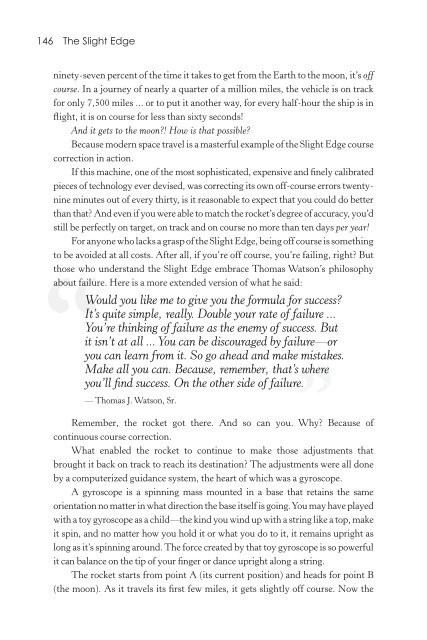The-Slight-Edge
Create successful ePaper yourself
Turn your PDF publications into a flip-book with our unique Google optimized e-Paper software.
146 <strong>The</strong> <strong>Slight</strong> <strong>Edge</strong><br />
ninety-seven percent of the time it takes to get from the Earth to the moon, it’s off<br />
course. In a journey of nearly a quarter of a million miles, the vehicle is on track<br />
for only 7,500 miles ... or to put it another way, for every half-hour the ship is in<br />
flight, it is on course for less than sixty seconds!<br />
And it gets to the moon?! How is that possible?<br />
Because modern space travel is a masterful example of the <strong>Slight</strong> <strong>Edge</strong> course<br />
correction in action.<br />
If this machine, one of the most sophisticated, expensive and finely calibrated<br />
pieces of technology ever devised, was correcting its own off-course errors twentynine<br />
minutes out of every thirty, is it reasonable to expect that you could do better<br />
than that? And even if you were able to match the rocket’s degree of accuracy, you’d<br />
still be perfectly on target, on track and on course no more than ten days per year!<br />
For anyone who lacks a grasp of the <strong>Slight</strong> <strong>Edge</strong>, being off course is something<br />
to be avoided at all costs. After all, if you’re off course, you’re failing, right? But<br />
those who understand the <strong>Slight</strong> <strong>Edge</strong> embrace Thomas Watson’s philosophy<br />
about failure. Here is a more extended version of what he said:<br />
Would you like me to give you the formula for success?<br />
It’s quite simple, really. Double your rate of failure ...<br />
You’re thinking of failure as the enemy of success. But<br />
it isn’t at all ... You can be discouraged by failure—or<br />
you can learn from it. So go ahead and make mistakes.<br />
Make all you can. Because, remember, that’s where<br />
you’ll find success. On the other side of failure.<br />
— Thomas J. Watson, Sr.<br />
Remember, the rocket got there. And so can you. Why? Because of<br />
continuous course correction.<br />
What enabled the rocket to continue to make those adjustments that<br />
brought it back on track to reach its destination? <strong>The</strong> adjustments were all done<br />
by a computerized guidance system, the heart of which was a gyroscope.<br />
A gyroscope is a spinning mass mounted in a base that retains the same<br />
orientation no matter in what direction the base itself is going. You may have played<br />
with a toy gyroscope as a child—the kind you wind up with a string like a top, make<br />
it spin, and no matter how you hold it or what you do to it, it remains upright as<br />
long as it’s spinning around. <strong>The</strong> force created by that toy gyroscope is so powerful<br />
it can balance on the tip of your finger or dance upright along a string.<br />
<strong>The</strong> rocket starts from point A (its current position) and heads for point B<br />
(the moon). As it travels its first few miles, it gets slightly off course. Now the













